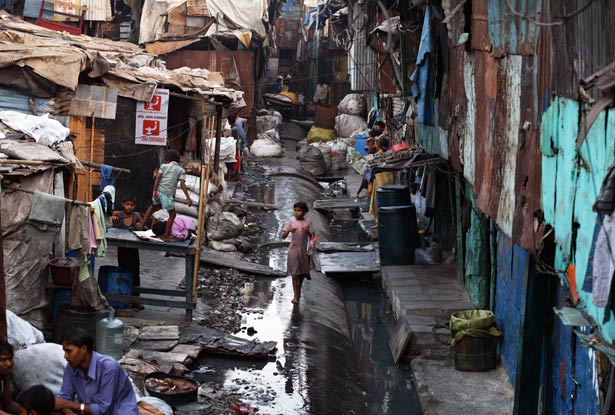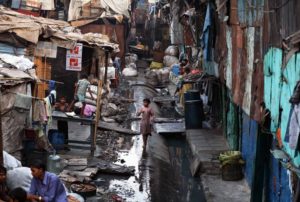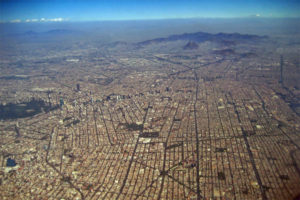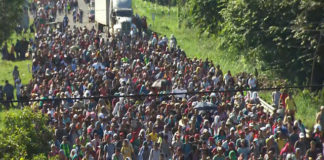
Climate change isn’t even the half of it as failed states collapse into violent chaos unleashing human tsunamis across a planet that’s been bled dry, gutted and boned
First in a series on our impending doom
By Mark Cromer
Denial is a powerful sedative.
I am reminded of this every time I listen to politicians or elected leaders of any political persuasion or ideological stripe start plucking the harp strings of promises to act today with responsible policies so that younger and future generations will inherit a brighter tomorrow.
Sometimes I suspect it’s a dark goof offered with an absurdist’s tip-of-the-hat to the obvious, much like a stand-up comedian would deliver a punch-line with a straight face before breaking into a grinning advisory of ‘But seriously, folks, your kids, your grandkids and future generations? Yeah, well, they’re totally screwed.’
But other times I think some of them actually may feel they’re not being completely dishonest as they tick off their multi-point policy plans for a better tomorrow, at least to the self-hypnotic extent that Seinfeld’s George Costanza’s once explained: ‘It’s not a lie if you believe it.’ So perhaps they’ve talked themselves into a mild trance that allows them, however briefly, to believe or appear to believe their own sugar-frosted pablum they regurgitate for public consumption.
Yet whether the bipartisan political leadership in this country or bureaucratic suits running the Western world actually believe their own hype about the promise that tomorrow may yet hold is ultimately immaterial to the grim tide of reality that is now unfolding across the planet.
The End isn’t near. It’s already here. The only question is how long will it last before the bright lights of humanity suddenly go dark?
And while the sirens wail throughout the world’s capitals over the climate change that is indisputably manifesting across the planet, there is only the accompaniment of crickets in the halls of power to the rising sea of people. It’s a strange juxtaposition watching world leaders breaking into cold sweats about a warming planet even as they offer little more than blank stares of befuddlement when confronted with a human population that has far outstripped the carrying capacity of the planet and is adding corrosive multipliers with every monthly net gain of humanity.

The science is clear and compelling and confronts us with challenges that are already overtaking humankind’s historic ability to adapt and evolve to navigate shifting environments and new threats. Throughout modern human existence our innate resourcefulness and inventive nature has been able to keep us enough steps ahead of danger to not only preserve our species, but propel it into absolute ascendance above all others on the planet, a dark meteoric rise that continues to lay thousands of other species low in our wake.
But even the blinding pace of technological advances in the adolescence of the 21st Century will not be enough—not even close—to pull a rabbit out of the hat of salvation yet again, even if that is the laudanum being peddled and passed out now to the masses. The snake oil of 2017 is the idea that brilliant young minds who are busy writing code and developing apps even as you read this are going to save the day.
No, they’re not.
Not because they are not young, brilliant and possibly even visionary, but rather because they are facing problems too vast, too deep and multiplying too rapidly to overcome in time to prevent collapse.
The most dangerous time during a flight on a jetliner is during takeoff and landing, in part because the pilots are actually flying the plane at those points which increases the odds of ‘human error’ but also because the lack of altitude presents pilots with precious little time to assess and react to correct the problem if possible. Altitude equals time. The human population on the planet today is at about 1,000 feet off the deck with an airspeed of 400 knots and the jackscrew is about to snap on the elevator.
The accelerating collapse of wild habitats, depletion of vast ground water aquifers, clear-cutting of vital forests, billowing dead zones in the oceans and the globalization of the food supply chain has all unfolded against a backdrop of an endless surge of human population growth.
Yet can anyone recall a single question being asked or perspective being offered about human population growth, whether across the planet, the hemisphere and the country, during Election 2016? Or Election 2012? Or Election 2008? Or…
You can’t recall a single question or a coherent answer on the issue of overpopulation—even to challenge the argument that it’s a problem—because the global governing elites that got us into this mess over the past century by their failure to seriously address it at numerous critical junctures during the past half-century are now steadfastly locked into a Non-Disclosure Agreement with the media, a dutiful routine of ‘Don’t Ask, Don’t Tell.’
They are overpopulation deniers.
And yet the rapidly accelerating consequences of overpopulation are now unavoidable.
The frenzied mass migration of tens of millions of people fleeing the civil wars and societal collapse across the Middle East and Africa is an obvious symptom of what tomorrow and the day after that holds much more of, but it is hardly the only one. In an above the fold, front-page feature article published in Sunday’s national edition of The New York Times, reporter Michael Kimmelman offered a stark portrayal of the day-to-day reality for a vast sweep of the 21 million people that are now jammed into the crumbling megalopolis of Mexico City. Headlined ‘A Parched and Sinking Capital’ the article’s subhead advises readers that ‘Mexico City’s Water Crisis Pushes It Toward The Brink’.
But toward the brink of what exactly?
Mexico has already achieved all the hallmarks of a failed state; historic and endemic corruption of an archaic and malignant patronage system that pervades virtually every level and branch of its municipal, state and federal government; spiraling street violence and Narco-Cartel battlefronts that have claimed hundreds of thousands of lives and ‘disappeared’ thousands more people, sometimes busloads at a time; and a non-existent or crumbling infrastructure, a stunted public education system and a vast disparity of not just wealth but even the dim hope of economic opportunity altogether. More than two decades after the passage of the North American Free Trade Act that was supposed to raise the financial boats of workers north and south of the Rio Grande, the average daily wage for Mexicans in Mexico continues to hover around five American dollars—or about half of what a busboy can make in a single hour in the United States.

A report published by Business Insider in 2015 declared “Mexico’s wage crisis is so bad that it violates what’s stipulated in [its] Constitution” and noted that 20-percent of Mexico’s population had an average net worth of $80. And another front page story published in the Los Angeles Times on Sunday explored how Delphi Automotive eliminated 20,000 jobs in America in 2006 and moved their plants to Mexico, where the company today pays its Mexican workers $1 an hour for the same work it had paid American workers $30 an hour to do a decade ago. While Americans poured into unemployment lines and extended economic misery, many of the Mexican workers were only advancing from abject squalor to dirt poor.
Kimmelman’s story in The New York Times offers vivid snapshots of just how bad daily life has become in Mexico’s teeming capital, reporting that around 5 million of its residents—or a population larger than that of Los Angeles—do not have access to clean water at any given time. Simply put, when more than 5 million residents of Mexico City turn their tap, whether its actually in their home or somewhere else on the block, nothing comes out. When there is actually water coming out of the taps, it’s often a yellow hue that looks like another liquid altogether and makes the drinking water scandal in Flint, Michigan, look like a simple mistake that’s a quick fix. The dwindling supplies of drinking water have forced many among the impoverished masses of the capital’s inhabitants to devote much of their daily lives improvising ways to acquire water and Kimmelman describes the plight of Diana Contreras Guzmán, a young single mother in the Xochimilco district who shares a single-room cinder-block shack with five other adults and four children. While the five other adults all work fulltime to earn a combined monthly income of $600, Guzmán watches over the children at the shack and is responsible for obtaining several hundred gallons of water each week that are brought into the neighborhood by delivery trucks and donkeys. She’s also tasked with guarding whatever water is on hand at their shack, since water theft is daily threat in the district.
Another resident of Mexico City, Virginia Josefina Ramirez Granillo of the Iztapalapa District, put it blunty: “We wait for hours to get water that doesn’t last a week, and usually there aren’t enough [privately owned trucks selling water]. Sometimes there is violence. Women sell their spaces in line. If you are from the wrong political party, you don’t get water.”
The detailed and unflinchingly frank reporting of Kimmelman’s story is at once a testament to the power and importance the tradecraft of print journalism still retains even as it exposes its fundamental flaws and ultimate impotence to prevent or even long delay the reckoning that is pulling into the station.
While Kimmelman’s story again brings into focus the catastrophe that is taking shape and building in strength like a perfect storm in Mexico City—to say nothing of dozens of other massive urban population centers that are imploding under their own weight across the globe—he is careful to carry the water of The Times editorial orthodoxy and not connect the dots of climate change, accelerating chaos and an unsustainable human population.
In fact, throughout the entirety of his feature news story, Kimmelman made not a single direct reference to overpopulation as a root cause of the crisis that is now unfolding. While he certainly set the table well enough to clearly understand the connection, he apparently dared not quote even one source that openly explored whether the vast and still growing population of the Mexican capital was the explosive component being packed into another human population time bomb. Or perhaps Kimmelman did indeed diligently report on how an unsustainable human population directly correlates with squandered and vanishing vital resources such as fresh water but The New York Times editorial equivalent of the NKVD redlined those passages into obscurity for being ‘politically inappropriate.’
Either way, unsustainable human overpopulation is riddled like cancer cells between the lines through Kimmelman’s bleak report.
In 1950, Mexico City covered approximately 30 square miles. Today, its vast footprint sprawls across 3,000 square miles in a portrait of what author Mike Davis had warned of more than a decade ago in his book Planet of Slums. In what Davis called “humanity’s final buildout,” the human population on the planet has not been fleeing cities that can no longer provide basic services, but rather are getting sucked into them in a vortex-like gravitational pull of a dying star. In 1950, when Mexico City was a mere 30 square miles, there were 86 cities across the globe that had populations of more then one million people. By 2006, there were nearly 400 cities that had populations over a million and today that number has surpassed 500 and is expected to approach 700 by 2030. It’s projected that by 2050, three out of every four humans on the planet will be living in cities, albeit choked, congested and collapsing ones.
But it’s in what Davis described as ‘megacities’ that have populations of 10 million or more and ‘hypercities’ like Mexico City where 20 million or more people live where the implosions will explode human blast radiuses that will threaten to swamp countries not already mired in chaos.
Kimmel’s story notes the by mid-century the failed states and staggering birthrates of humankind will have pushed 700 million people around the globe into perpetual migratory status—or a population twice that of the United States today that will be running, walking, stumbling, swimming, floating and being carried ever northward. As the writer Christian Parenti put it to Kimmelman: “No amount of walls, guns, barbed wire, armed aerial drones or permanently deployed mercenaries will be to save one half of the planet from the other.”
In other words, think World War Z.
And it has already begun. The proverbial ‘tipping point’ was reached and passed some time ago. Greenpeace co-founder and Sea Shepherd Conservation Society founder Paul Watson told me a quarter century ago that a sustainable peak human population on the planet was around 2 billion people and yet we’re cresting ever closer to double-digit billions.
The Rubicon has been crossed. Peak humanity is here.
From the Mideast and out of Africa tens of millions of refugees are already on the move and across the vast swathes of poverty in Mexico, Central America and South America the floodgates are creaking. In India, the populations of Mumbai and Calcutta have collectively surpassed 30 million people, or nearly the entire state of California between two cities. In Lagos, Nigeria, the sprawl of the ‘greater metro’ area encompasses more than 21 million people jammed into shanties stretching as far as the eye can see.
And in Southern California, nearly 25 million people have poured into a densely populated coastal region that is naturally arid, creating a water-dependency system that has bled the Central and Northern regions of the state bone dry, and yet the only thing growing faster than drought restrictions or dead lawns are new multifamily housing developments.

One evening back in the mid-1980s I was at a small dinner party in Los Angeles with some academic and musician friends along with Gregg Turner, guitarist of the LA punk band Angry Samoans who also wrote for the rock magazine Creem, and he and I discussed the global population issue and I recall Turner’s wry observation that the invention of the combustion engine and the development of antibiotics were two of the greatest disasters to strike the planet.
Reflecting on Stanford biologist’s Paul Ehrlich’s earlier work, Turner had concluded that short of a global consensus and dramatic collective action it would soon be too late to avoid collapse and then nature’s ensuing correction of a population grown wildly disproportionate to the resources necessary to sustain it.
“If they don’t start turning it around within the next decade,” Turner said. “You can pretty much party up, because it will be over.”
I told him that I’d already gotten a jump on living like tomorrow was an iffy layaway plan, so I was prepared for the worst. Years later I’d have the chance to talk with Paul Ehrlich in Washington D.C. and he left me feeling that Turner and I had it right that night, with the only question now being how fast the decline accelerates into a cascading collapse?
And that’s an open question. But given the multipliers in play now, it seems likely that most of us will live to see the opening acts make way for the headliner event in the coming years.
So as Gregg Turner advised: you can pretty much party up, because it will be over…sooner than later.
Cheers!
(and to T. Bobby Malthus, one of the very first cats to see it coming…)










